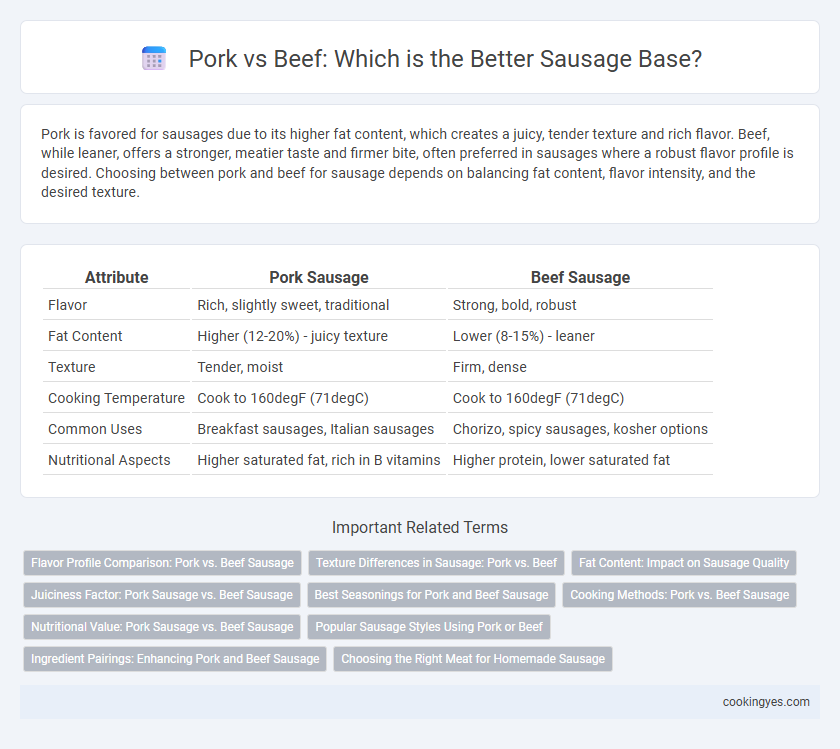Pork is favored for sausages due to its higher fat content, which creates a juicy, tender texture and rich flavor. Beef, while leaner, offers a stronger, meatier taste and firmer bite, often preferred in sausages where a robust flavor profile is desired. Choosing between pork and beef for sausage depends on balancing fat content, flavor intensity, and the desired texture.
Table of Comparison
| Attribute | Pork Sausage | Beef Sausage |
|---|---|---|
| Flavor | Rich, slightly sweet, traditional | Strong, bold, robust |
| Fat Content | Higher (12-20%) - juicy texture | Lower (8-15%) - leaner |
| Texture | Tender, moist | Firm, dense |
| Cooking Temperature | Cook to 160degF (71degC) | Cook to 160degF (71degC) |
| Common Uses | Breakfast sausages, Italian sausages | Chorizo, spicy sausages, kosher options |
| Nutritional Aspects | Higher saturated fat, rich in B vitamins | Higher protein, lower saturated fat |
Flavor Profile Comparison: Pork vs. Beef Sausage
Pork sausage typically offers a sweeter, richer flavor with a higher fat content that enhances juiciness and mouthfeel, making it ideal for traditional sausage varieties. Beef sausage usually delivers a stronger, more robust taste with a slightly leaner texture, providing a hearty and savory profile that pairs well with bold spices and seasonings. Choosing between pork and beef as a sausage base directly influences the overall flavor complexity and texture, catering to different culinary preferences and recipe requirements.
Texture Differences in Sausage: Pork vs. Beef
Pork sausages typically offer a tender and juicy texture due to higher fat content, which melts during cooking and enhances mouthfeel. Beef sausages tend to have a firmer, denser texture with less fat, resulting in a chewier bite that emphasizes the meat's natural grain. The choice between pork and beef as a sausage base significantly influences texture, impacting flavor release and overall eating experience.
Fat Content: Impact on Sausage Quality
Pork contains higher fat content, typically around 20-30%, which contributes to juicier and more flavorful sausages with better texture and mouthfeel. Beef usually has lower fat levels, ranging from 10-20%, resulting in leaner sausages that may require added fat to prevent dryness and improve taste. The fat composition directly impacts the sausage's moisture retention, binding properties, and overall palatability, making pork the preferred base for traditional sausage recipes.
Juiciness Factor: Pork Sausage vs. Beef Sausage
Pork sausage typically offers a higher juiciness factor compared to beef sausage due to its greater fat content, which helps retain moisture during cooking. Beef sausage tends to be leaner, often resulting in a drier texture unless additional fat is incorporated. The marbling and fat distribution in pork contribute significantly to its succulent and tender bite, making it a preferred choice for juicy sausage varieties.
Best Seasonings for Pork and Beef Sausage
Pork sausage benefits from warm, aromatic seasonings like sage, fennel, garlic, and black pepper that complement its rich, fatty profile. Beef sausage pairs well with stronger, robust spices such as cumin, coriander, smoked paprika, and chili flakes to enhance its leaner, savory flavor. Balancing herbs like thyme or rosemary with savory notes elevates both pork and beef sausages for a flavorful, well-rounded taste.
Cooking Methods: Pork vs. Beef Sausage
Pork sausage offers a higher fat content that ensures juiciness and tenderness, making it ideal for grilling, frying, and pan-searing methods that emphasize moisture retention and crisp outer textures. Beef sausage, being leaner, benefits from slower cooking techniques such as baking, smoking, or simmering to prevent dryness and develop deeper flavors through prolonged heat exposure. Both meats respond differently to cooking times and temperatures, with pork requiring shorter, higher-heat cooking while beef demands lower temperatures to maintain succulence.
Nutritional Value: Pork Sausage vs. Beef Sausage
Pork sausage typically contains higher fat content, providing a richer flavor and more calories compared to beef sausage, which is leaner and lower in saturated fat. Beef sausage offers a greater concentration of iron and zinc, essential for blood health and immune function, whereas pork sausage is often a better source of thiamine and vitamin B6, supporting energy metabolism. Both types of sausages supply important protein, but the choice between pork and beef impacts nutrient balance based on fat, vitamin, and mineral content.
Popular Sausage Styles Using Pork or Beef
Popular sausage styles using pork include Italian sausage, bratwurst, and chorizo, prized for their rich fat content and tender texture. Beef sausages, such as kielbasa and Coney Island hot dogs, offer a leaner alternative with a robust flavor profile. Many traditional recipes blend pork and beef to balance juiciness and savory depth in sausages.
Ingredient Pairings: Enhancing Pork and Beef Sausage
Pork sausage pairs exceptionally well with herbs like sage, thyme, and rosemary, as well as spices such as fennel and garlic, enhancing its rich, slightly sweet flavor. Beef sausage benefits from bold ingredient pairings like smoked paprika, chili flakes, onion, and black pepper to complement its hearty, robust taste. Combining complementary ingredients tailored to each meat base elevates the overall flavor profile and creates a more balanced, flavorful sausage.
Choosing the Right Meat for Homemade Sausage
Pork remains the most popular choice for homemade sausages due to its ideal fat content, which ensures juiciness and flavor. Beef offers a leaner alternative but often requires added fat to achieve the desired texture and succulence in sausage recipes. Selecting the right meat base depends on balancing moisture, fat percentage, and flavor profile to suit specific sausage styles and personal taste preferences.
Pork vs beef for sausage base Infographic

 cookingyes.com
cookingyes.com